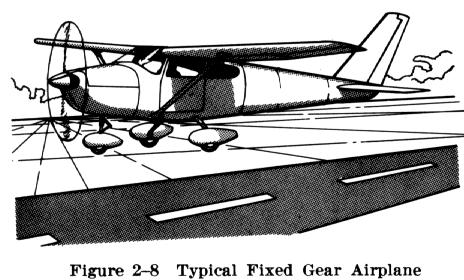The landing gear of many light airplanes is fixed in the extended position (Fig. 2-8), while in the so called complex airplanes it is retractable in flight.

The main landing gear forms the principal support of the airplane on land or water. It may include wheels, floats, skis, shock absorbing equipment, brakes, retracting mechanism with controls and warning devices, and structural members necessary to attach the gear to the primary airplane structure. The airplane also has either a tailwheel or a nosewheel, or may have a tail skid. The tailwheel or nosewheel also supports the airplane on the ground but steering and directional control are their primary functions.
Modern airplanes having the nosewheel installation are called tricycle
gear airplanes. A nosewheel gear arrangement has at least three advantages:
1. It allows more forceful application
of the brakes during landings at high speeds without resulting in the airplane
nosing over.
2. It permits better forward visibility
for the pilot during takeoff, landing, and taxiing.
3. It tends to prevent ground looping (swerving) by providing more directional stability during ground operation, since the airplane's center of gravity (CG) is forward of the main wheels. The forward CG, therefore, tends to keep the airplane moving forward in a straight line rather than ground looping.
The main landing gear assembly consists of two main wheels and struts.
Each main strut is attached to the primary structure of the fuselage or
the wing. With the tailwheel type of airplane, the two main struts are
attached to the airplane slightly ahead of the airplane's center of gravity.
In the nosewheel type, the two main struts are attached to the airplane
slightly to the rear of the airplane's center of gravity.
| The landing gear shock struts may be either self-contained
hydraulic units or flexible spring like structures that support the airplane
on the ground and protect the airplane's structure by absorbing and dissipating
the shock loads of landing and taxiing over rough surfaces, much as they
do on automobiles. Many airplanes are equipped with what is known as oleo
or oleo/pneumatic struts, the basic parts of which are a piston and a cylinder.
The lower part of the cylinder is filled with hydraulic fluid and the piston
operates in this fluid; the upper part is filled with air. Several holes
in the piston permit fluid to pass from one side of the piston to the other
as the strut compresses and expands and forces the piston back and forth.
The landing gear of many light airplanes is fixed in the extended position (Fig. 2-8), while in the so called complex airplanes it is retractable in flight. |
 |